Category:110 State and Federal Wage Rates and Other Requirements
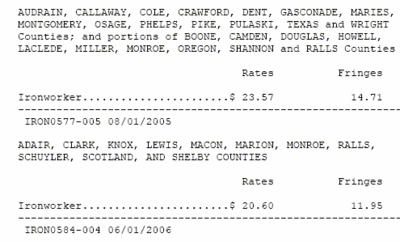
Missouri and federal law often require minimum wage rates (pay) for the various skilled trades. These wage rates are specified in the contract at the time of bidding and are enforced by MoDOT and the Department of Labor during the construction of the project. Typical MoDOT contracts that do not require Wage Rate Determinations are railroad adjustments, utility adjustments and some Maintenance funded projects.
Two flowcharts are available to help guide the application of wage rate compliance, one for federally funded projects and one for state funded projects.
110.1 Wage Rates (Guidance for Sec 110.1)
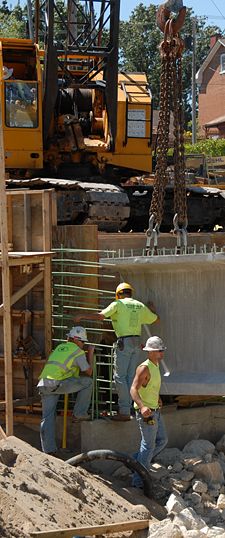
Contractors on MoDOT projects are required to pay the appropriate state or federal prevailing hourly wage rate for any craft or type of worker required to perform the work, except when expressly provided by the contract document.
The state and federal wage rates are posted on MoDOT’s website. MoDOT will post the applicable wage rates 10 days prior to the bid opening. In instances where the wage rates change within the 10-day window, MoDOT will not update the wage rates since doing so will not provide contractors sufficient time to accommodate the revised wage order in their bids.
To view the wage rates for a specific letting on MoDOT's website, select the desired letting date, click the "Submit" button and then proceed to State Wage Rates and Current Federal Wage Rates. The full wage order must be posted on the bulletin board or may be kept in the job trailer or in the foreman's truck for employee inspection. Employees should be made aware where the complete wage order is kept if the entire packet is not posted on the bulletin board. In lieu of placing the complete wage order on the bulletin board, the contractor can create a spreadsheet (a one page document) that shows the wages for the county in which the project is located. This would include listing each of the crafts along with the appropriate wage that is to be paid under the contract for each craft. In addition, at the bottom of the one page document, the contractor must indicate where on the project the complete wage order may be found.
The resident engineer or delegated representative is responsible for monitoring compliance with the wage rate laws at the project level. Wage Rate Compliance Checks (WRCC) shall be performed on active projects when applicable. WRCC consist of two major items: Reviewing Payrolls and Wage Rate Interviews.
Payrolls, wage rate interviews and all other labor compliance related documents are to be kept in the resident engineer's office for the duration of the project. Paperless payrolls that are submitted electronically are stored on a server. After project completion, payrolls shall be stored for a period of three years.
To ensure compliance there are three areas of quality assurance that are performed:
| Payroll training, “Payroll Reviews for Prevailing Wage Rate”, is available through MoDOT U |
- Training. A yearly payroll training will be conducted for all project clerks or other designees that perform the payroll reviews in project offices. A payroll training review course is also available through MoDOT U for new hires and as a refresher for existing employees.
- Quality Assurance. The final plans processor in each district will select one job every 6 months from each project office to review. They will be checking payrolls, wage rate compliance, C-220s and other pertinent items.
- RE review. A wage interview report is generated monthly indicating the number of wage interviews required vs. performed for each project. This report is generated by the Administrative Technician (or as assigned by the RE) and sent to the Resident Engineer.
110.2 Federal-Aid Projects (Guidance for Sec 110.2)
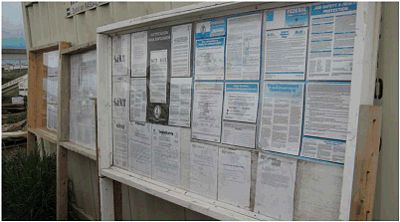
For any contract where a federal rate applies, the greater of the federal or state rate shall be paid.
Required Notices and Posters
The contracts for highway construction projects require certain information to be conspicuously displayed on the project where employees regularly congregate in preparation for the day's work. Notices must be posted on a bulletin board that is readily accessible to the employees on the project. For mobile operations, the bulletin board should be placed at the staging area where employees congregate at the start of each work day. The number of locations will depend on the contractor's operations. The resident engineer, or a delegated representative, is to conduct inspections of the bulletin boards. The first inspection should occur when employees begin work on the project. After the initial review, inspections should be conducted every three months until the project is completed to ensure the bulletin board is in good condition and still displays the required posters.
The Required Notices and Posters are available on the MoDOT website.
110.3 Prevailing Wages and Records (Guidance for Sec 110.3)
Sec 110 indicates the detail that is required of the contractor payroll.
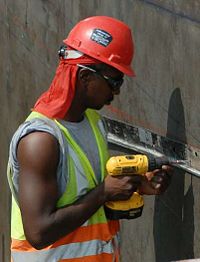
Each prime contractor, contractor, subcontractor and subordinate shall furnish weekly a digital certified payroll of wages paid to each of their employees on all projects except those that do not contain Wage Rate Determinations by federal or Missouri law. Payroll information must also include workers on the project provided as part of a rental agreement. One certified copy of labor payrolls must be submitted for each week that work is performed. For contracts that include multiple projects, it is allowable for the work hours to be displayed per contract rather than per project. However, work that extends across multiple counties must be paid per the rate in each county if the wage rates differ between the counties. Optionally, the contractor can just pay the highest rate of all counties where work was performed that week in lieu of showing hours separately per county. Differing overtime and holiday rules may also trigger the need to break hours down per county.
Each payroll shall be accompanied by a statement of compliance signed by the contractor, subcontractor, or their agent who pays or supervises the payment of persons employed under the contract, and shall certify that the payroll for the pay period contains the information required and that such information is correct and complete (Certified Statement of Compliance).
The prime contractor must submit a certified copy of each weekly payroll within 7 days of the payment date of the payroll. The certified statement of compliance may be on the payroll itself or on a separate document. The prime contractor will be considered responsible for submittal of payrolls and certifications for all subcontractors on the project within 7 days as well. The certification must be digitally signed and submitted electronically. The prime contractor should be advised that failure to submit these payrolls within the 7-day period may result in delay in submittal of the engineer's payment estimates for those projects involved. The resident engineer shall keep a log of all payrolls received as described under Item No. 3 Payroll Log, below.
Occasionally a subcontractor will refuse to sign the prevailing wage affidavit because of a pay dispute with the prime contractor. The prevailing wage affidavit is required by RSMo 290. Therefore a refusal to sign this document is in violation of Missouri law. The prime contractor, in accordance with this law, has the right to withhold final payment if the subcontractor does not submit the affidavit. The prompt payment law is not enforceable until the subcontractor submits the affidavit.
A best practice is to notify the subcontractor that a refusal to sign the document is in violation of law. This will only harm the subcontractor and not the prime. There are better options for subcontractors to pursue payment. They can contact the bonding company and file a claim against them. They can also pursue civil action against the prime contractor.
Electronic payrolls should not be printed, but should be saved in the “Pending” folder until checked, then moved to the “Checked” folder. The following steps should be included in all payroll checks to ensure proper labor compliance:
- Payroll Checklist for Every Payroll
- 1. Payroll Violations
- a. Document any "Payroll Violations" found based on the requirements in this checklist.
- b. Notify the contractor of the violation and track the actions taken until it has been corrected.
- 2. Statement of Compliance
- a. Make sure each payroll has a Certified Statement of Compliance with an approved contractor digital signature.
- b. Make sure each Statement of Compliance covers one week (seven-day period).
- c. If there is no work for the entire week, no Statement of Compliance is needed for that week. Note this fact in the payroll log as described in the following items.
- d. Statement of compliance must list all deductions that are included on the payroll.
- 3. Payroll Log
- a. A payroll log is required to track payrolls received to ensure a certified payroll is on file for every week in which work was performed. A payroll log form is available for this purpose. A separate log is required for the prime and each subcontractor. All logs shall be stored in eProjects. Payrolls are identified by the date range that they represent. Weeks in which there was no work activity do not require a payroll, but it should be noted in the payroll log that no work was performed that week. Once the final payroll is received, this should be noted in the remarks section of the payroll log.
- b. The payroll log should include: Date range for the week, Checkbox indicating if work was performed, Date Payroll Processed (This is the date the contractor processed payroll. The contractor is required to submit payrolls within 7 days of this date.), Date Received (This is the date MoDOT received the payroll if work was performed.), Checkbox indicating if the payroll was reviewed by MoDOT staff (This will help monitor how many payrolls were checked.), and a Comments field for special notes.
- c. Run a Cognos report each week to reveal all contractors who were present on the project that week. Check the indicator box in the payroll log for all active contractors to show that a payroll is required. It is paramount that inspectors accurately note the presence of all contractors in their DWR so that the Cognos report accurately reflects a list of active contractors for the payroll checker.
- 4. Name and Employee Identifying Number
- Make sure the employee’s full name and an employee identification number (such as last four digits of Social Security Number) appear on each payroll. The contractor is not allowed to include complete Social Security numbers or employee addresses on certified payrolls. The Prime Contractor is responsible for the submission of copies of payrolls by all subcontractors. Contractors and subcontractors shall maintain the full social security number and current address of each covered worker, and shall provide them upon request to the Contracting Officer (Commission), the Contractor, or the Wage and Hour Division of the Department of Labor for purposes of an investigation or audit of compliance with prevailing wage requirements.
- 5. Classification
- a. Check to ensure each employee has a classification.
- b. Make sure classifications are correct as related to the type of work the company has subcontracted (if applicable).
- c. Employees enrolled in the MoDOT training program must be shown on the payroll in the classification they are enrolled in as trainee. (i.e. Crane Operator Trainee, Carpenter, Laborer, etc.)
- d. Missouri State statute RSMo 290.235 requires that the ratio of apprentices to journeyman shall not exceed a 1:1 ratio.This requirement is per contractor and per trade on a project and not on the aggregate of all contractors performing work. If the ratio is exceeded the contractor is required to pay a journeyman rate to an apprentice or apprentices as needed to meet the requirement of a 1:1 ratio. The apprentice selected to receive the journeyman rate is at the discretion of the contractor.
- e. When possible, confirm that employees are classified correctly as to what type work they are performing by using the interview process, jobsite visits, communication with the inspectors, and by reviewing the Inspector’s Daily Report of Construction.
- f. Foremen or supervisors who perform 20% or less of the day with the tools of the trade are exempt from the Davis Bacon Act. They must appear on the payroll as "foreman" or "supervisor" with a breakdown of hours per day and total hours and, since hourly wage rates are not required, they can be listed under Salary Agreement.
- g. Foremen or supervisors who work with tools of the trade more than 20% of the day are not entitled to an exemption under the Davis Bacon Act. Thus, if the hourly wage rate is the same for both classifications the employee will be listed on the payroll to show both classifications in which they performed (i.e. Foreman/Carpenter), hours per day listed, along with an hourly wage rate, gross amount earned, deductions and net wages paid. But, if the hourly wage rate is not the same for both classifications then multiple listings for the employee shall be included on the payroll to show each classification of work performed in each day along with all the appropriate information.
- 6. Rate of Pay
- a. The rate of pay, and other items described below, should be checked to the extent that all information is reasonably accurate. Checking of all payrolls is recommended, but this may not be feasible in all cases due to other priorities. As a minimum, all initial payrolls from each contractor should be thoroughly reviewed. For subsequent payrolls, a thorough checking process should be established to ensure the payrolls are accurate. As a general rule, a complete check (100% of the payroll) of at least half of all payroll submittals on each project is a sufficient frequency to screen for errors. Further checking might be necessary for those contractors found to have frequent errors, while checking less than half of the payrolls may be sufficient for contractors who display extreme competence with payroll compliance. Checking of the calculation of total pay is generally not required unless the payrolls are not automated. Check employees’ rate of pay against the state and federal wage rates to make sure they are receiving at least the minimum for their classification as per the prevailing wage schedule in the contract. For federally funded projects the rate of pay to be used is the higher of either the federal or state wage rates in cases where the overtime rules are the same. If the overtime rules differ, the contractor must ensure the employee is paid the higher total amount per pay period after applying the appropriate overtime rules. For instance, the state base rate may be lower than the federal base rate, but after applying the state overtime rules the total compensation for the pay period might be higher than the federal rate and federal overtime rules.
- b. Make sure fringe benefit amount, plus base pay amount, matches or exceeds the designated fringe benefit amount, plus designated base pay amount, from the applicable wage order. For example, the base pay amount could be less than that designated as the prevailing wage, if the fringe benefit amount is more than that designated, and the two together meet or exceed the designated gross prevailing wage. The contractor should be encouraged to list the exact fringe paid for each employee on the payroll. If the contractor chooses to certify that the fringe benefits are being paid to approved plans, funds, or programs, the contractor shall provide documentation that the correct payment amount is being paid to the fund for the individual employees.
- c. If an apprentice is used on the project (whether or not there is an OJT Goal) the contractor must submit written evidence of the registration of apprenticeship programs and certification of trainee programs, the registration of the apprentices and trainees, and the wage rates prescribed in the applicable programs. To fulfill this documentation requirement, the apprenticeship documentation must state the name of the employee, the apprenticeship program they are enrolled in, and the applicable percentage of prevailing wage that the apprentice must be paid. Contact MoDOT’s Business Development and Compliance at (573) 526-2978 for help to determine the proper apprenticeship documentation.
- 7. Deductions
- a. All deductions must be identified. If a deduction of “other” is listed on the payroll it must be explained on the statement of compliance.
- b. Some typical standard deductions include
- 1) State or federal taxes
- 2) Voluntary insurance, pension, and/or retirement plans
- 3) Child support and other payments ordered by a court (but not payments to the employer)
- 4) Prepaid wages
- 5) Payments to charitable organizations
- 6) Union dues when agreed to by the union (fines are not allowable)
- c. Any non-standard deductions that are not listed in 7(b) must be pre-approved by the employee prior to performing the work. The contractor must provide a copy of the employee-signed agreement (i.e. payroll deduction form) for all non-standard deductions. If the employee does not speak English, such agreement shall be written in the employee's native language. This agreement form should be kept on file with the certified payrolls. Subsistence reimbursements, such as lodging, travel and meals are the most common examples of non-standard deductions that an employer might withhold when the employer is providing those services to the employee. MO Statute 290.315.1 requires MoDOT to pre-approve these non-standard deductions as fair and reasonable before the start of work. The contractor shall provide sufficient documentation to verify the deductions are fair and reasonable. Such documentation shall include lease or rental arrangements for housing linked to each employee and receipts or invoices for food and/or travel expenses linked to each employee. For amounts expended by the contractor on behalf of multiple employees, such as multiple employees residing in a single rental unit, each employee's subsistence deduction shall reflect a pro-rata share or less of the expense. Subsistence deductions shall comprise exclusive column(s) on certified payrolls, not to be mixed with garnishments, child support or any other deduction.
- 8. Interviews
- a. Check all interviews taken within the period covered by the payroll.
- b. Conduct Wage Rate Interviews according to the frequencies listed in EPG 110.3.1.
- c. Check interviews against payroll, and record any discrepancies on the Employee Interview Form CR-1 and in AASHTOWARE Project (AWP).
- 9. Electronic Filing of Payrolls
- a. After payrolls have been checked for compliance, and corrected if necessary, the checker shall digitally sign the payroll in the upper right-hand corner of the first page to indicate review of the payroll is complete.
- b. Electronic payrolls shall be saved in eProjects.
Certified Payroll Exceptions
Lead Workers/Foreman/Supervisor
Lead workers must be paid no less than the prevailing hourly wage for the classification they are working in. If a lead worker is salaried, the contractor must provide documentation of the amount actually paid and the hours actually worked. Salaried superintendents are not covered by prevailing wage provisions and are not required to be listed on the certified payroll. Refer to EPG 109.5.1 Daily Force Account Record, Labor Account for additional information.
Professional Services
When a contractor hires a Professional Service to perform a support function that does not fit into a federal or state job classification, those workers do not need to be listed on the certified payroll (see exceptions under Other Duties Performed by Contractor Personnel below). Some examples of Professional Services include Material Testing Service, Inspection Service, Smoothness Profiling Service, Surveying/Staking, etc. Even though a Surveying/Staking company is considered a Professional Service and generally does not require workers to be listed on a certified payroll, it may require a subcontract if there is a contract pay item for this work. Refer to EPG 108.1 Subletting of Contract for additional information. A certified welder hired by a contractor to perform specialty welding would be an example of a Professional Service that would require a certified payroll since that work falls under the classification for Ironworker.
Other Job Duties Performed by Contractor Personnel
When a contractor provides personnel to perform a function that does not fit into a federal or state job classification, those professional or specialty workers generally do not need to be listed on the payroll. Examples would include Material Testing, Inspection, Surveying/Staking, etc. However, workers who support these functions and perform laborer-type duties, do need to be paid prevailing wages. For example, survey helpers whose primary function is to perform physical work, such as clearing brush for staking or driving heavy stakes (such as paving hubs), are considered laborers and shall be paid prevailing wages.
Owner-Operator
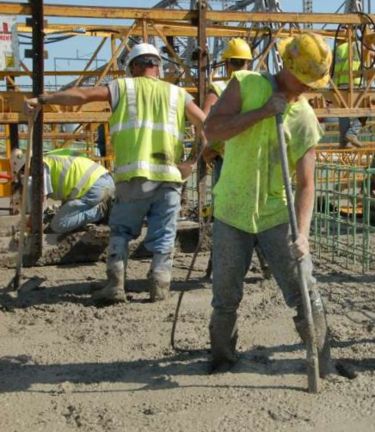
In lieu of submitting a C-220 (Request to Subcontract Work), a contractor may request permission to rent a piece of equipment that comes with an operator who also owns that equipment. This is commonly referred to as an “owner-operator” arrangement. The RE can approve these arrangements as long as the following conditions are met:
- 1. The operator must be the owner, or partial owner, of the equipment.
- 2. No other employees of the owner-operator can operate the equipment or perform any other work on the project.
- 3. No other family members of the owner can operate the equipment unless they can provide proof they are partial owners.
- 4. The contractor must provide verification from the owner-operator that the owner-operator is receiving no less than the contract prevailing wage.
- 5. The owner-operator must be covered under the contractor’s insurance policy.
- 6. The contractor shall not exceed the contract sublet limits.
Equipment Rental with Operator and Purchase Ordered Work
A prime contractor using rental equipment that is provided with an operator, via purchase ordered work or other financial arrangement, must include the operators on the certified payroll of the prime contractor, subcontractor or the company providing the equipment. All related documentation must be provided by the contractor to substantiate this arrangement. The operators are subject to wage rate interviews and are to be paid prevailing wage on prevailing wage contracts. This is to ensure a legitimate arrangement is being used, not an attempt to circumvent prevailing wage rate laws.
Application of Prevailing Wage both on and off the Worksite (aggregate production, material deliveries, plant set-up, equipment maintenance, etc.)
Some work associated with a project may be performed away from the project site. This work may, or may not, be subject to prevailing wage. A wage flowchart for federal jobs and a wage flowchart for state jobs are provided for reference; however, the contractor is advised to seek legal advice when applying the charts. MoDOT cannot predetermine how the law may be interpreted in any particular instance.
110.3.1 Employee Interviews
The resident engineer or delegated representative shall conduct contractor employee interviews (also known as wage rate interviews) as part of the Wage Rate Compliance Checks (WRCC). The wage rate interview is necessary to verify compliance with wage rate laws.
For all state and federal funded projects, wage rate interviews shall be conducted at an average rate of one interview per each two weeks that work is active, except for Job Order Contracts. Wage interviews for Job Order Contracts shall be conducted at a rate of one interview for each month that work is active. These established wage interview frequencies are per contract and are entered into AWP without a job number designation. The completed Employee Interview Form CR-1 is saved in e-Projects under the primary job number on combination projects.
The wage rate interview frequency should increase during periods of high activity so that compliance can be verified on a wide range of worker classifications and/or subcontract workers. This also helps maintain the desired average rate during periods of low activity and small crews.
When inaccuracies are found in WRCC, the frequency of interviews should increase until the RE has confidence that the contractor is in compliance with the wage rate laws.
On smaller jobs it may be possible to interview every employee over time. There is no need to interview an individual a second time unless additional interviews are justified. Once everyone on a job has been interviewed, a note can be used for documentation and wage interviews can cease until new employees are present on the job.
All wage rate interviews must be recorded on the Employee Interview Form CR-1. All questions on the form must be asked during the interview and a response noted.
For tracking purposes, interview occurrences should be designated in AWP as a Daily Work Report (DWR) “Wage Interview” remark type. The remark must begin with a single digit numeric character in order for the Cognos report to correctly calculate the number of wage interviews conducted for a given contract (for example, “2 wage interviews conducted today…”).
110.3.2 Errors, Omissions and Non-Compliance
When there is any condition or evidence that suggests that the labor laws are not being fully complied with, the resident engineer shall investigate until satisfied of lawful compliance. Investigations shall be limited in nature and cases beyond our investigative ability should be referred to the Divison of Labor. Poor compliance efforts by the contractor should be noted on the Contractor Performance Evaluation.
When payrolls are not submitted within 7 days and/or contain errors, the resident engineer should notify the contractor and encourage them to improve. Payrolls containing errors should be corrected and resubmitted in a timely manner. When payrolls are routinely late and there is no effort to improve on the contractors part, the resident engineer should withold payment until the next regular estimate date after compliance is attained.
When a wage rate is believed to be below the contractual lawful minimum, the Division of Labor should be notified. The Divison of Labor will open a complaint case at the request of MoDOT, the employee, the union, or other third party. The Divison of Labor will perform an investigation and then close the complaint either as a violation or non-violation. The resident engineer should ensure a copy of all correspondance from the Divison of Labor is kept in the contract files.
110.3.3 Semi-Annual Labor Report
The district construction engineer is to submit a semi-annual report to the main office containing the following information:
- a. Number of contractors/subcontractors against whom complaints were received.
- b. Number of investigations completed.
- c. Number of contractors/subcontractors found in violation.
- d. Amount of wage restitution found due under:
- (1) Davis-Bacon and related acts.
- (2) Work Hours Act of 1962 (The Davis-Bacon Act encompasses prevailing wage rate violations, whereas the Contract Work Hours Act encompasses daily and weekly overtime violations).
- e. Number of employees due wage restitution under Davis-Bacon and related acts and/or Work Hours Act of 1962.
- f. Amount of liquidated damages assessed under Work Hours Act of 1962.
Due dates for the Semi-Annual Labor report are:
| Reporting Period | Due Date |
|---|---|
| October 1 to March 31 | April 4 |
| April 1 to September 30 | October 5 |
The above report is due not later than April 4 for the period from October 1 to March 31, and not later than October 5 for the period from April 1 to September 30. This report should include all information gathered on Federal Aid Projects. The report should be submitted to Construction and Materials, Central Office, Attention: Jennifer Smith.
110.3.4 Missouri DOL Form PW-2
The project office or contractor are not required to provide this form to the Missouri Department of Labor and Industrial Relations (DOL). DOL and MoDOT agreed that MoDOT Construction Division will submit a listing of all newly awarded contracts to DOL at the first of each month. This listing would be in lieu of the PW-2 form.
If the DOL PW-2 form is requested, the following standard statement is available for a reply:
- “The issue of filling out a PW-2 form had been previously discussed with Department of Labor in June of 2016. It was agreed that MoDOT would send a project award notification to DOL at the first of each month. This would be in lieu of the PW-2 form. Brenda Hentges with Department of Labor was our contact on this matter. Brenda is sent the monthly updates and can provide you the necessary information.”
110.4 Work Performed in Adjoining States (Guidance for Sec 110.4)
Sec 110 provides information on contracts that involve work in Missouri and in an adjoining state.
110.5 Other Requirements
110.5.1 Open Records Policy (Sunshine Act)
The Missouri Open Records Law (Sunshine Act) requires governmental agencies to conduct business in a manner open and accessible to all citizens and make their records available to the public. The vast majority of our records may be shared with the public upon request. Some information, however, should not be released. When responding to requests for information, the procedures outlined in the Sunshine Act Policy should be followed. The district construction engineer and each resident engineer have been provided a copy of this policy to assist in responding to requests for information. If the request requires the removal of records from the office, personnel must be available at all times to accompany the records to ensure that they are not lost or destroyed.
110.5.2 Equal Employment Opportunity
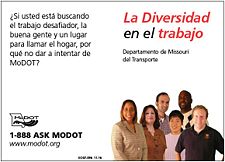
All federal-aid contracts contain specific requirements related to equal opportunities in employment for all persons or contain requirements of a Hometown Plan with the same objectives. These requirements are as much a contractual obligation as any other part of the standard specifications.
A Resource Manual for Equal Opportunity Contract Compliance is issued to all project offices contains detailed information concerning E.E.O. matters.
The resident engineer has a responsibility to ensure that the contractor and any nonexempt subcontractors are complying with the specific EEO requirements. To assist the resident engineer in this area, Construction & Materials prepared questionnaires, Resident Engineer EEO Checklist, to be used for checking the various aspects of the EEO Compliance portion of the Federal-Aid contract. Detailed instructions are contained in the E.E.O. Contract Compliance Resource Manual. A statement of compliance must be completed by all contractors on the project, excluding suppliers and vendors.
From time to time, contractors and subcontractors may be subjected to a detailed compliance review. This may be conducted by the Federal Highway Administration or by the Business Development and Compliance Division. On occasion, this may be done by both representatives. The district may also be requested to conduct such reviews as needed. The reviews will take place at the jobsite and include interviewing the contractor’s workforce.